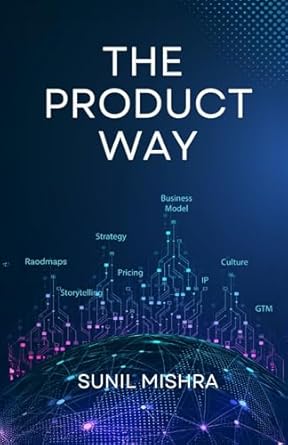1. What motivated you to write The Product Way, and who would benefit the most from it?
I have worked in the software product industry for over 25 years. Over the years, I’ve watched digital product management evolve from something niche into a field that’s central to how businesses operate. Yet, despite its growing importance, it lacks a structured approach to understanding. Since it is an emerging field even most universities don’t offer courses in this area. I wrote The Product Way to provide a structured approach to studying this topic.
The book could be useful for software product professionals, academicians, and students keen to explore this dynamic domain. Drawing from real-world experiences, this book delves into the everyday complexities faced by product managers and provides actionable insights to overcome them.
2. What are some common misconceptions about digital product management?
One of the biggest myths is that product managers just developing more features for the product. While that is important, the role of the product manager is to have a larger vision and strategy for the product to manage the life cycle end to end. It is more about strategy than mechanical execution.
Another misconception is that PMs “own” the product like a CEO owns a company. In truth, product management is more about influence than authority. You work with engineers, designers, marketers, and stakeholders—none of whom report to you—but you still have to align them toward a shared vision.
And then there’s the idea that you must be highly technical. While technical knowledge is useful, the real skills that make a PM effective are understanding users, thinking strategically, and making good decisions under uncertainty.
3. How important are soft skills in product management, and which ones matter most?
A product manager has to get his work done with influence and very little authority. Hence, soft skills are critical. You can have the best product strategy in the world, but if you can’t communicate it well, get buy-in from stakeholders, or lead teams effectively, it won’t go anywhere.
Some of the most essential soft skills for a PM are:
- Empathy – Understanding both your users and your team. Design thinking is a crucial component, especially during the product incubation phase.
- Storytelling – Making people see the why behind your product decisions. I have covered this as a separate chapter in my book.
- Negotiation – Finding the right balance between business, technology, and user experience. Product prioritisation is mainly about creating the right balance.
4. Can you share a real-world challenge you faced as a product manager and how you overcame it?
One of the biggest challenges I faced was launching a conversational banking solution in a market that was still unfamiliar with AI-driven customer interactions. There was scepticism from banks regarding security, compliance, and customer adoption. To overcome this, we focused on extensive user research, designed a phased rollout, and partnered with regulatory teams to ensure compliance.
By demonstrating real-world use cases and incremental adoption strategies, we successfully implemented the solution across multiple banks, proving its value.
5. How has AI and emerging technology changed the role of product managers?
AI has transformed product management, but not in the way people might think. It hasn’t replaced PMs—it has shifted what we focus on.
Now, instead of spending hours collecting and analysing data manually, AI tools can do that instantly, allowing PMs to focus more on strategy. One of the biggest changes is in personalization—products today are expected to adapt dynamically to users. AI-driven recommendations, chatbots, and automation are no longer “nice-to-have” features; they’re baseline expectations.
That said, while AI is powerful, the best PMs know that technology alone isn’t enough. The real challenge is figuring out how to use it in a way that adds value to users.

6. What makes product management in banking different from other industries?
One major difference is regulation. In banking, you can’t just launch and iterate as quickly as in consumer tech. Every feature needs to go through compliance checks, and that means timelines are longer.
Also, customer expectations are different. People don’t want a “fun” banking app—they want security, reliability, and ease of use. What works in e-commerce or social media doesn’t necessarily work in finance.
That said, fintech has changed the game. Traditional banks are being forced to innovate faster than ever, and PMs in banking now have to balance two competing priorities—stability and agility.
7. What advice would you give to someone trying to break into product management?
Three things:
- Start before you have the title – You don’t need a PM job to think like a PM. Do self-learning, improve a process at work, or volunteer to own a feature in your current role.
- Become obsessed with problem-solving – Great PMs don’t just build features, they solve problems. Ask “why” things work the way they do and how they could be better.
- Get comfortable with uncertainty – There’s rarely a perfect answer in product management. You have to make decisions with incomplete information and adjust along the way.
I have set up a LinkedIn page, “The Product Way”, that provides periodic insights about product management practices.
8. How do you balance business goals with user experience when developing a product?
It all comes down to prioritisation. If a feature boosts revenue but makes the product frustrating to use, it’s a short-term win but a long-term loss.
In the book I have discussed several frameworks for feature prioritisation. I often use the RICE framework (Reach, Impact, Confidence, Effort) to evaluate initiatives. This helps ensure that we’re not just reacting to the loudest stakeholder but actually making data-driven decisions that balance business and user needs.
9. What frameworks or methodologies do you find most useful in product management?
I have provided a list of product management frameworks and tools in the appendix section of the book. Some of the key frameworks that I have used are:-
- Storytelling – Defining and communicating the right narrative for your product that captures the value proposition.
- Design Thinking – Build fast, test early, and iterate based on feedback.
- OKRs (Objectives and Key Results) – Helps teams focus on outcomes, not just output.
The key is adapting these frameworks based on the context rather than following them rigidly.
10. Where do you see the future of product management heading?
Product management is evolving beyond just “building software”—it’s becoming about orchestrating ecosystems. AI, automation, and API-driven platforms mean PMs now have to think at a systems level, not just about individual features.
I also see Agentic AI (AI-powered decision-making) playing a bigger role. PMs will need to work alongside AI—not as a replacement, but as a tool to enhance human decision-making.
At the same time, the best PMs will need to broaden their skill set. It’s no longer enough to understand technology—you also need to grasp behavioural psychology, data science, and regulation.
Ultimately, the PMs who succeed will be the ones who stay adaptable—always learning, questioning assumptions, and focusing on real-world impact.



























